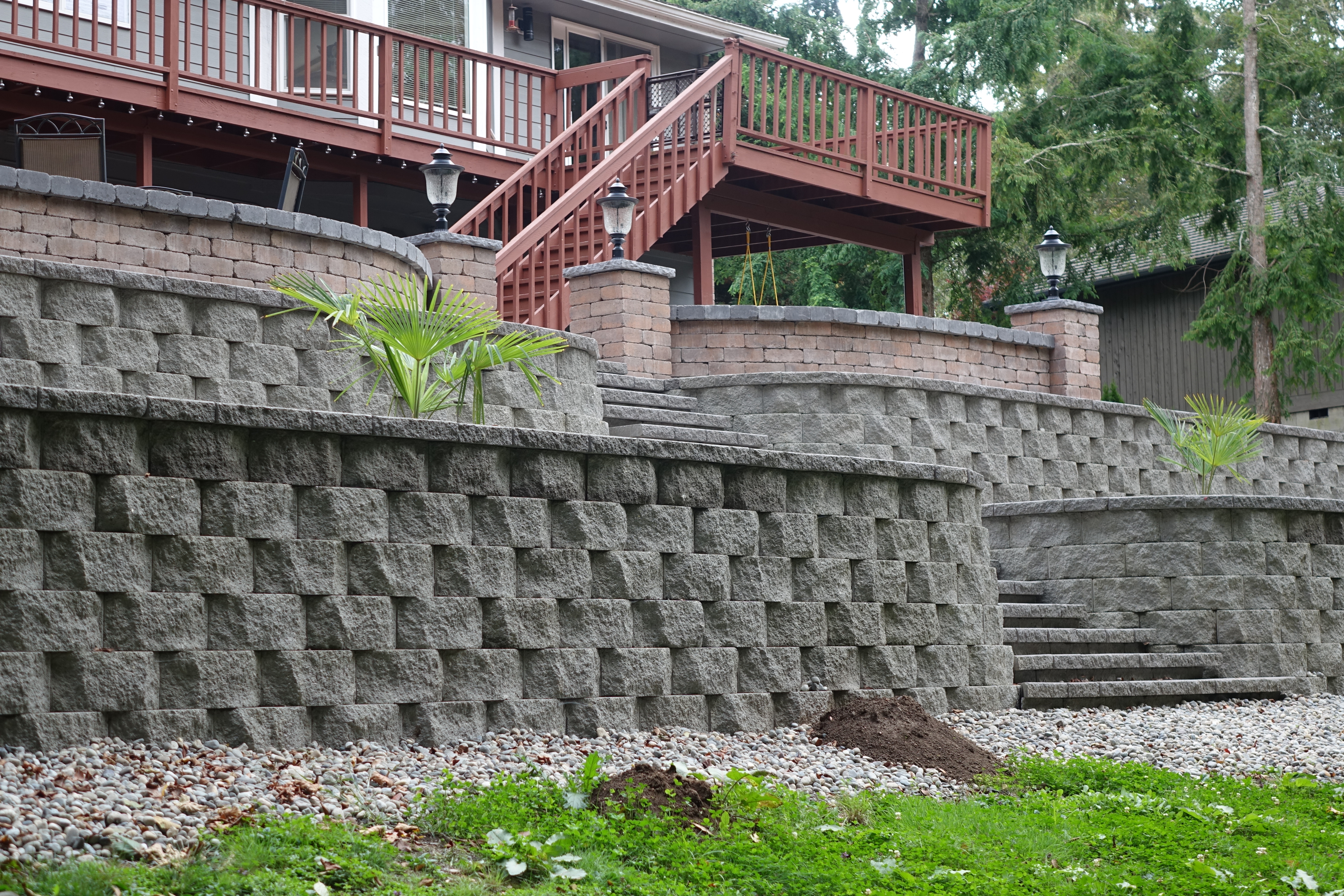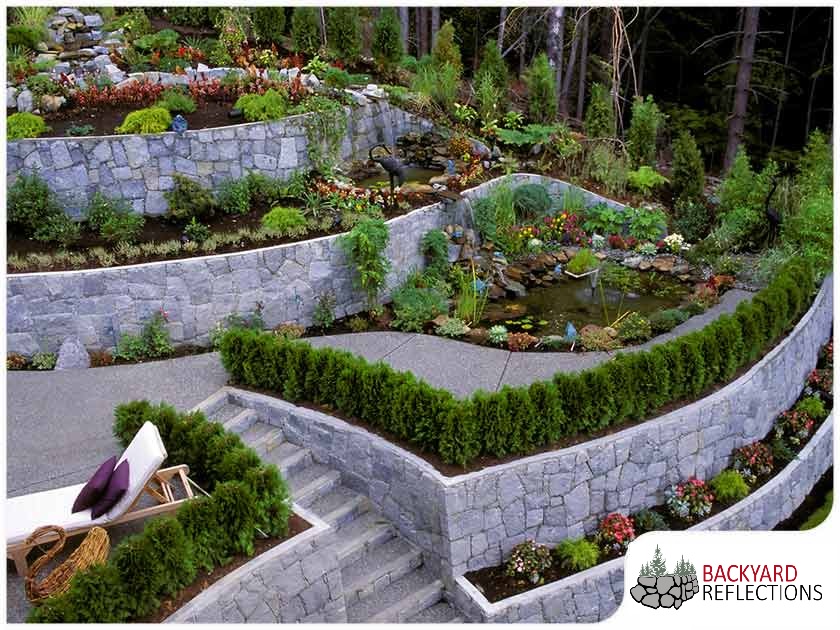Secret Factors To Consider for Building Effective Retaining Walls in Your Lawn
When you're taking into consideration building a retaining wall in your lawn, it's vital to think concerning a number of essential factors. The wall surface's objective, the materials you'll utilize, and the particular dirt problems can all affect its effectiveness and longevity.
Comprehending the Function of Your Retaining Wall
When you think concerning developing a maintaining wall, consider its primary function: stabilizing dirt and avoiding disintegration. Retaining walls provide vital support for sloped landscapes, helping to keep soil stability. You'll discover they're important in areas where water overflow might or else wash away dirt, resulting in pricey repair work and landscape damages.
By holding back earth, these walls produce degree surfaces for yards, outdoor patios, or paths. This not only improves your backyard's aesthetic appeals yet likewise advertises far better drainage, lowering water pooling in unwanted locations. If you're dealing with steep slopes, a well-constructed retaining wall can protect against landslides, making certain safety and security for you and your residential property.
Ultimately, recognizing the objective of your retaining wall will certainly direct your style decisions and assist you create a useful, sturdy structure that satisfies your needs. So, take a moment to review your landscape; it'll repay in the future.
Picking the Right Products
When choosing materials for your retaining wall, you'll wish to think about durability, aesthetic appeals, and expense. Each element plays an important role in ensuring your wall surface stands the test of time while looking excellent and fitting your spending plan. Let's discover just how to make the most effective choices for your job.
Material Toughness Factors
Choosing the ideal materials is crucial for the longevity and effectiveness of your retaining wall, given that their resilience directly influences the wall surface's ability to endure ecological stress and anxieties. Start by considering your regional environment; materials like concrete and stone withstand moisture and temperature variations well. If you stay in an area susceptible to hefty rains, go with products with good drain residential or commercial properties, like crushed rock or permeable blocks, to stop water buildup.
Some products do much better in details soil types, so it's essential to match them as necessary. Selecting resilient materials guarantees your retaining wall surface stands solid, shielding your yard for years to come.
Aesthetic Style Options
Long lasting materials not just assure your retaining wall's structural stability however also play a crucial role in its visual allure. When picking the best materials, consider exactly how they enhance your landscape. Natural stone uses a timeless, rustic look, while cinder block can give a sleek, modern finish. You may also take into consideration using lumber for a cozy, natural feeling. Color and appearance issue, also; pick shades that integrate with your home and garden. Do not fail to remember concerning the wall surface's form-- rounded walls can create a softer look, while straight lines can really feel much more structured. By very carefully choosing materials that straighten with your visual vision, you'll enhance your outdoor room while guaranteeing your wall stands strong versus the aspects.
Cost-Effectiveness Evaluation
Choosing the appropriate materials for your retaining wall isn't just regarding visual appeals; it's additionally essential for your budget plan. When selecting products, take into consideration both ahead of time costs and long-term longevity.
Don't forget to element in maintenance expenses also (OKC Precision Retaining Walls). Some products, like all-natural rock, can include appeal and call for much less maintenance, while others could require normal therapies
Inevitably, consider the benefits and drawbacks of each option versus your spending plan and the wall surface's desired objective. Spending sensibly in products now can stop expensive issues later on. Select products that stabilize cost and performance efficiently.
Analyzing Dirt Problems and Drain
As you start your task, evaluating dirt conditions and water drainage is important for the success of your retaining wall. Sandy soil drains well but lacks security, while clay dirt can maintain dampness, leading to press on your wall.
Following, examine the slope of your backyard. If water naturally moves towards your wall surface, you'll require to apply a drain service to avoid erosion and pressure accumulation. Think about mounting perforated pipelines or gravel backfill behind the wall surface to promote drainage.
Lastly, observe any type of neighboring trees or plants; their origins can affect dirt stability. By recognizing your soil problems and executing correct drainage, you'll produce a strong foundation for your retaining wall surface that stands the examination of time.
Abiding By Local Building Regulations
Prior to you begin developing your retaining wall surface, you require to research local laws click this link to guarantee compliance. It's necessary to comprehend what allows you have to obtain, as this can save you from expensive penalties or having to renovate your work. Taking these actions seriously will aid you construct a safe and effective framework.
Research Local Regulations
Recognizing local laws is crucial when intending your retaining wall surface job, specifically considering that constructing codes can vary considerably by place. Begin by contacting your regional building department or district to discover certain demands. Search for standards on wall elevation, materials, water drainage systems, and architectural honesty. Several areas have constraints on the kinds of materials you can use and how high you can develop. You'll additionally desire to think about the zoning legislations that could affect your job. Ignoring these policies can result in costly penalties or the demand to remodel your work. By doing your research upfront, you can ensure your retaining wall surface meets all needed codes and blends seamlessly into your lawn.
Obtain Needed Permits
When you have actually investigated neighborhood laws, the following action is to obtain the needed licenses for your retaining wall surface project. This process assurances your wall abides by structure codes and safety requirements. Connect why not try here to your local building authority to figure out what permits you need. They may need details strategies or engineering evaluations, particularly for bigger walls. Be prepared to submit detailed drawings, including dimensions and products. Do not neglect to examine if your project influences drain or surrounding residential or commercial properties, as these elements could require added permits. Protecting the right approvals can save you from expensive penalties or having to dismantle your wall surface later. Bear in mind, complying with the rules now will cause a smoother construction experience.

Planning the Design and Aesthetic Appeal
As you begin planning the layout and aesthetics of your retaining wall, consider just how it will harmonize with the bordering landscape. Think of the products you'll utilize-- stone, brick, or concrete-- and just how they'll complement your home's style and the all-natural elements in your backyard. Choose shades and appearances that blend seamlessly with existing attributes like outdoor patios, paths, or gardens.
Following, visualize the wall's shape and elevation. Curved walls can soften a stiff landscape, while straight lines may share a much more modern-day appearance. Don't fail to remember to integrate plants and plant around the wall for an all-natural touch; this can improve its charm and incorporate it into the setting.
Last but not least, bear in mind capability. Your layout ought to not just be aesthetically pleasing however additionally offer its function efficiently. By thoughtfully planning these components, you'll develop a maintaining wall that boosts your yard's charm while fulfilling its structural duty.
Calculating Height and Thickness Requirements
To develop a durable retaining wall, you require to accurately determine its elevation and thickness demands based on the soil conditions and the height of the slope it will certainly sustain. Begin by examining the slope's angle and the sort of soil, as various dirts exert differing quantities of pressure.
For walls over four feet high, take into consideration you could look here a thickness of a minimum of 12 inches. If the wall is taller, boost the thickness proportionally to keep security.
Following, compute the height of the wall by measuring the vertical range it requires to preserve. For each foot of height, you should commonly prepare for a thickness of one-third of the wall's elevation.
Constantly bear in mind to make up added variables like water drainage and backfill, which can affect your wall's style. Correct estimations currently assure your retaining wall surface stands strong and lasts for years to come.
Maintenance and Long Life Considerations
While maintaining your retaining wall could appear like a reduced concern, ignoring it can cause considerable issues gradually. Routine evaluations are vital; check for cracks, protrudes, or any kind of indications of water damages. Dealing with these problems early can save you from pricey repair services later on.
Keep an eye on water drainage systems, as well. Blocked drains can cause water to develop, putting in pressure on your wall surface and jeopardizing its stability. Clear particles and assurance correct circulation to preserve long life.
You might also intend to show on securing your wall surface to shield it from dampness and weathering. Depending upon the material, this might require reapplication every few years.
Finally, landscaping around your wall can support its integrity. Prevent planting huge trees nearby, as their roots can undermine the structure. With proactive upkeep, your retaining wall surface can offer you well for many years to come.

Often Asked Concerns
Can I Develop a Retaining Wall by Myself, or Should I Hire a Professional?
You can certainly construct a keeping wall surface yourself if you have the right tools and expertise. However, employing a specialist guarantees it's done properly, especially for larger or even more intricate structures. Consider your skill degree prior to determining.
What Are the Most Typical Errors Made When Structure Retaining Walls?
When developing retaining walls, you could overlook proper drain, avoid utilizing the appropriate products, or forget reinforcement. These typical blunders can lead to structural failure, so take your time and plan thoroughly to prevent concerns.
Just how Do I Know if My Retaining Wall Demands Reinforcement?
You'll understand your retaining wall surface requires support if you observe splits, leaning, or protruding. Look for water merging behind it or dirt disintegration near the base. Address these indicators promptly to stop further damage.
What Plant kingdom Appropriate for Landscaping Around a Retaining Wall?
When landscape design around a maintaining wall surface, consider using low-maintenance plants like succulents, ornamental grasses, or slipping ground covers - OKC Precision Retaining Walls. They'll grow in those problems and include appeal while stopping soil erosion around your wall
How Can I Protect Against Disintegration Around My Retaining Wall?
To stop erosion around your retaining wall surface, you can grow ground cover, use mulch, and install water drainage systems. Routinely check for water build-up and change landscaping to reroute overflow away from the wall.